I don’t usually blog about the print jobs I do when I’m working at our local history museum. But it’s something I thoroughly enjoy, even if it does contrast with my own more curmudgeonly projects. I’ve decided I really should sing the praises of that lovely little print shop, nestled in Ottawa’s countryside, at the Cumberland Village Heritage Museum.
Most often, I print simple little souvenir pieces for the visitors: post cards, book-marks, the occasional greeting card. I don’t usually have time to plan or set anything more elaborate. The main objective is to provide historical interpretation of the print shop itself: to demonstrate the vintage equipment to visitors, to explain a bit about the processes of typesetting and printing; to mention a bit about the squared-log building that houses the print shop. And this has to be a fairly brief interaction, since many visitors are there with fidgety youngsters — and there is really so much to see at the museum.
The challenge is to give an abbreviated yet precise overview of the print shop in context to place and times (ie. rural Eastern Ontario in the 1920s & 30s), the trade, the history – and often in French to boot. (While I’m fairly comfortable working in French, I confess that I had some research to do to ensure I was using the right printing vocabulary in French! Who knew that a “printing press” in French is called “une presse typographique?!” )
The Equipment
It’s a tiny shop, consisting of a double-type cabinet with a few dozen cases of vintage type; a functioning Chandler and Price (14 x 22) New Series Platen Press (manufactured 1927), a guillotine paper cutter (c 1890s), a non-functioning Whitlock two-revolution cylinder press, a stately old Linotype machine, sitting forever silent in one corner. Apparently, the equipment once belonged to the Eastern Ontario Review, a regional newspaper founded nearly 125 years ago. But the linotype sports an inventory medallion from the Montreal Gazette, which got rid of its hot metal equipment in the mid-1970s. We also have a few table top platen presses, that I’m planning to use for little workshops and school programs. I’ve posted a few images here.
The C&P is in excellent shape and, with the help of a volunteer, we manage to get it going a few times each week. The guillotine needs sharpening, but is still used regularly for cutting card stock and other papers we use at the museum for educational and craft activities.
About the Print Shop Building
The print shop is housed in a “storey-and-a-half” house originally built in the 1890s. (This type of construction stems back to an earlier period, when residents of Upper Canada were taxed on the number of storeys in their homes. Many early settlers circumvented the tax by building homes with two levels and steep roofs, now known as Ontario Style Cottages. *)
Originally, the building served as a home, then a school dormitory, and then a home once again, in the town of Navan, some 10 kilometers south of the museum. When the museum acquired the house, sometime in the 1980s, a decision was made to lay down a cement foundation before relocating the house to its current site. Since it was designated to be the museum’s print shop (although it never was in its past life), large, heavy printing equipment was moved onto the cement pad before the building was reconstructed, log by log, around all the equipment.
The exterior was again re-clad with the wood siding added to the building by some previous owners; this was typically done to disguise the fact that the building was originally constructed with logs, which was perceived at the time as an indication of poverty. The squared logs themselves are still visible within the building itself; logs and chinking entirely whitewashed give it a roomy appearance. The six-over-six double-hung windows appear to be original, although some of the glass panes have been replaced over the years.
This Week’s Project
As Canada Day is approaching with alarming speed, staff are scrambling to get ready. The museum is a wonderful venue to celebrate the national holiday. While we have lots of visitors, it’s not nearly as crowded and crushed as the events held downtown, near Parliament Hill. If the weather holds, it’s a lively day filled with sunshine, kids and lots of laughter. Most of the buildings are decked out with red and white bunting; our heritage games are polished up for the kids, and the canteen is topping up supplies of period-appropriate junk food.
In preparation for the event, I’ve decided to print our national anthem, using the official bilingual version, rather than the original lyrics. I was lucky to find some fairly unblemished Caslon type in 30- and 36-point. (I’m always thrilled when I find type that has a selection of French diacritics, rare as hen’s teeth!) And, miraculously, we actually had enough type to set the whole text. Embellishing the text is a selection of vintage maple leaves from my own collection of blocks; I was thrilled to have an occasion to use them.
The truly strange thing is just how sniffly I became as I set the words to the anthem. Now I’m not an especially sentimental individual – and I would be horrified if someone were to find me weepy over a few little words like “stand on guard for thee” – but I must admit I was shocked by the flush of patriotism I felt as I set the type in the stick. Little fragments of Canadiana skidded around my brain; “Peace, Order and Good Government;” Banting & Best; Canadian boys, younger than my own, knee-deep in the mud of Passchendaele; 25,000 Syrian refugees, welcomed, sheltered here in the True North. Don’t get me wrong, I’m no sentimental slouch. Anyone who reads this blog knows that I can be quite the curmudgeon, but there’s something, something about picking up an old, chipped é from a dusty typecase in the heart of Eastern Ontario, in a museum full of historical artifacts about the roots of this nation, that can make even the most cranky carline weep at her heritage.
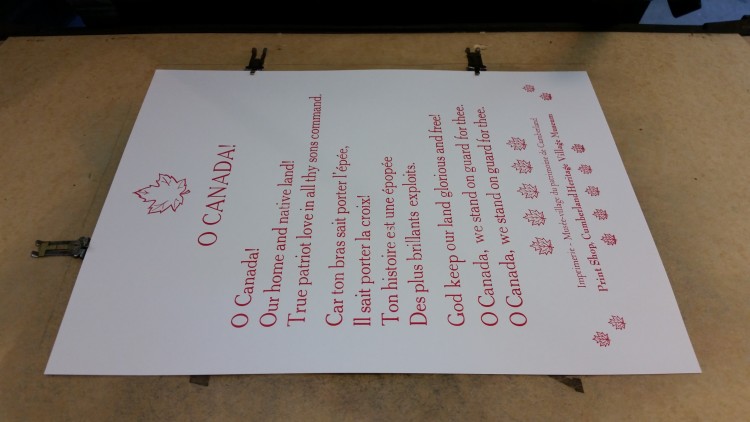
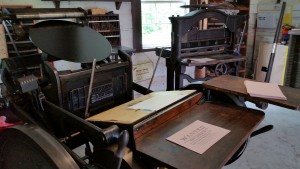
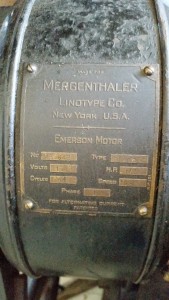
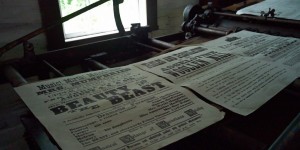

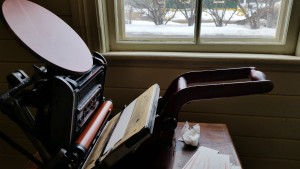
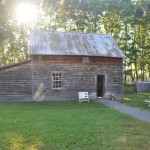
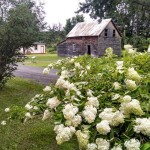
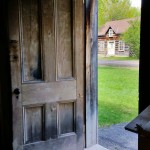
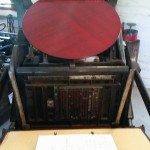
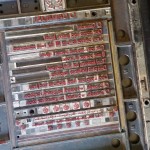
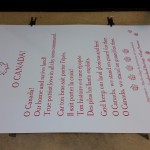
Beautiful. What a nice little story. So poignant. So interesting to read.
BTW – You can get new fonts of Old Style Caslon from my friend Bill Reiss at Quaker City Type. Bill casts the Caslon for the museum shop at Williamsburg and I have acquired a few fonts for clients wishing to be historically accurate with their typography.
2019 Horseshoe Pike, Honey Brook, PA 19344 Phone: (610) 942-3637
I am pleased – and proud – to hear that you have found my web site helpful.
Thanks for the kind words, Alan — and for the lead on the Caslon type!
Are you open to the public and if so what’s the address and admin fee
Hi Jason,
Cumberland Heritage Village Museum is now open for the season. It’s a City of Ottawa museum located at 2940 Old Montreal Rd in Cumberland. Fees are $8.50 for adults, $6.00 for youth/seniors, $21.50 for families. Children under 5 are free.
More information can be found at: https://ottawa.ca/en/arts-heritage-and-events/museums-and-historic-sites/cumberland-heritage-village-museum
Hope this helps!
Best,
Sue